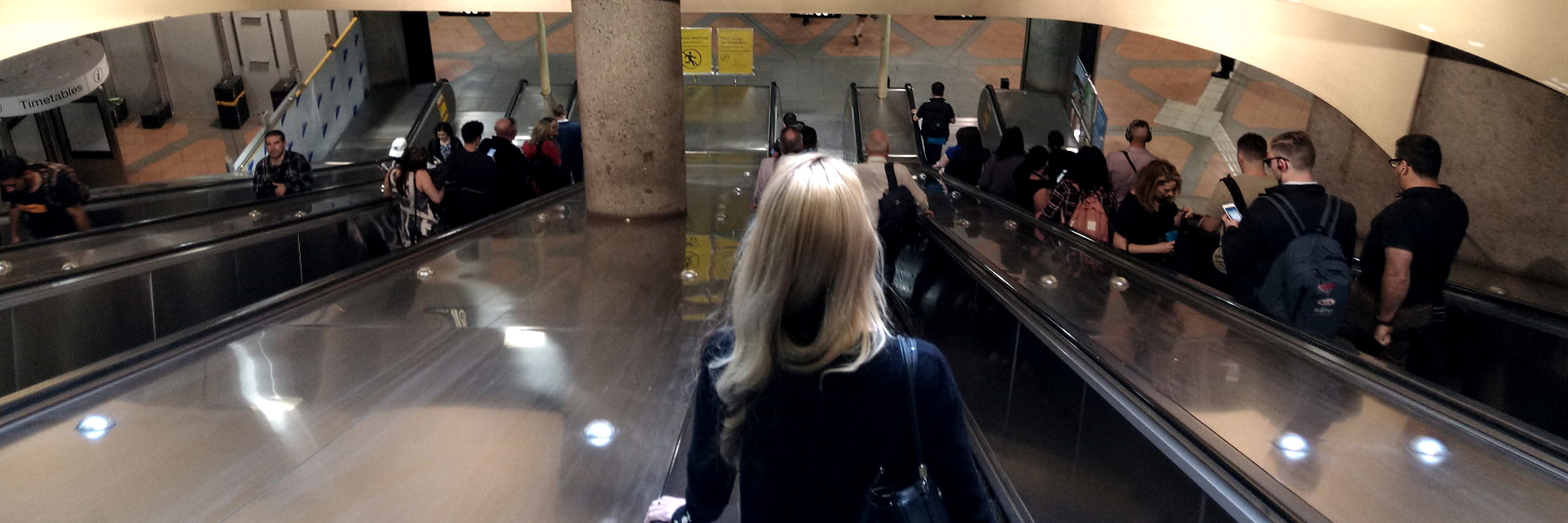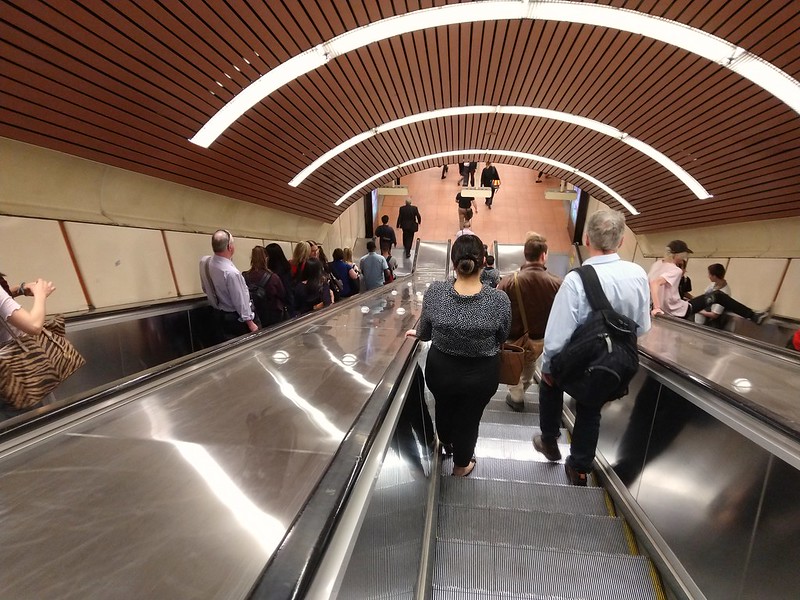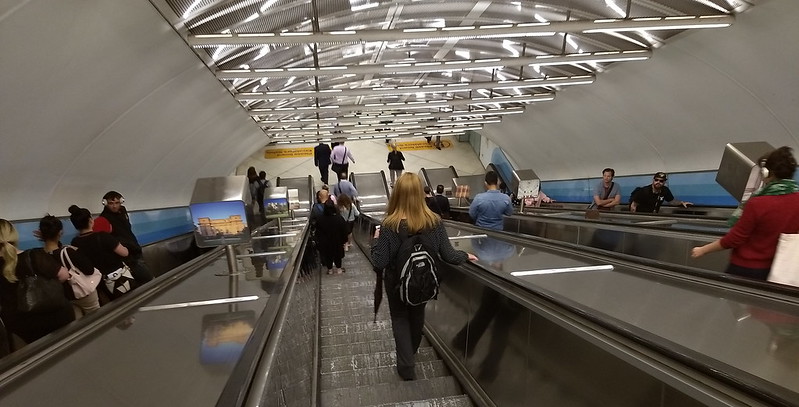It’s not your imagination. Some City Loop escalators are running slower in peak hour.
Normally: Fast in peak, slow off-peak
Normal practice (for decades now) is to run the Loop station escalators at a reasonable clip during peak hour, and set to slow down outside peak. This is pretty annoying for many of those catching trains at off-peak times.
Why slow them down outside peak? It’s not clear.
- Perhaps to save power – but isn’t the travel time of off-peak passengers important too?
- Perhaps some off-peak passengers are uncomfortable with the higher speed. But then, they have the option of lifts.
- Perhaps it’s one of those operational policies put into place in 1981 when the Loop first opened that’s never been reviewed.
Trialling slow speeds in peak
Anyway, just in the last couple of weeks Metro has been running the down escalators in peak at the slower speed at some stations.
They say it’s a trial to improve safety.
We’ve followed up with Flagstaff and a new escalator speed trial has begun at Flagstaff (and Parliament), designed to improve safety.
— Metro Trains (@metrotrains) October 15, 2019
The trial will involve slowing the speed of downward escalators during peak periods to reduce the risk of slips, trips or falls.
My initial reaction to slower speeds: I wonder if it could backfire:
- The slower speed may encourage more people to walk on the escalator, increasing risk of a fall
- It’s a known problem that some people overbalance or suffer from vertigo while standing on escalators. Slower escalators means they’re on them for longer. Would this mean more risk?
A study of 600 escalator incidents over 9 years showed people were more likely to fall off escalators going up than down – but slowing upwards escalators in peak would cause capacity issues – see below.
To my surprise, I’m hearing that the initial results of the trial have been favourable.
But I guess we’ll see how it pans out.
Escalator capacity: walking vs standing
By the way, some people claim that everybody standing (nobody walking) on escalators is faster. I think that’s slightly misinterpreting the results from the well-known London Underground trial back in 2015.
What it does provide is more capacity – because standing people are more space-efficient than walking people.
But it’s only faster if having both standing and walking is resulting in queues at the entrance to the escalator – this could particularly be an issue if the majority of people want to stand.
Southern Cross is pretty bad for escalator crowding, especially during their frequent outages.
Of the underground stations, Parliament station might be the worst for escalator crowding, particularly during morning peak. (See above)
In most cases I’d rather walk, but there might be some justification at that location to encourage everybody to stand.
It’s probably easier to convince people to stand if the escalators are not running slowly. And the faster speed will clear any queues more quickly of course.
At the northern end of Parliament, it might also be an option to ask the small number of people entering in morning peak to use the lift down to the platform rather than the mostly empty third escalator – opening up more capacity for those exiting. (This may not be an option at other stations with higher proportions of interchange and counter-peak flows.)
The design, capacity and provision of escalators is no doubt being studied carefully for the new metro tunnel stations. You’d hope they will handle expected growth in coming decades, especially at Parkville which may become a future Metro 2 interchange.
But building more escalator and lift capacity into existing underground stations would be incredibly expensive – so in the City Loop, this is another case where it makes sense to look at operational practices to make the most of the current infrastructure.




9 replies on “The ups and downs of escalators”
The argument to speed up congested escalators isn’t for everyone to stand, but for people to get on as quickly as possible regardless if they wish to walk or stand. People walking will still be able to and move forward to fill up more of the gaps.
From memory, the London Transport study was even more nuanced if you read the original report.
What they actually found was two effects.
The first was turbulence at the foot of the escalator as people sorted themselves into the walk and stand sides. Of course, the capacity of the escalator was no greater than that of the tunnel leading to the escalator, and the turbulence was restricting the tunnel, and hence escalator, capacity. The turbulence was least when the escalator was approached by a length of plain tunnel – this gave the experienced users (the majority) plenty of length to sort themselves. But many escalator feet were poorly designed, with intersections immediately at the foot, leading to significant congestion.
The second was people’s preference for walking or standing based on the rise of the escalator. On low rise escalators many people preferred to walk, conversely on high rise escalators relatively few people walked. At some height there simply wasn’t enough people willing to walk to fill it to capacity.
You can see both effects in Melbourne. The turbulence effect can very clearly be observed at almost any platform escalator going up from a platform after the arrival of a train. In particular, it can be seen at the foot of the upper escalators at Parliament in the morning peak, especially at the left most escalators. Not filling the walk side of an escalator is also very common, and is very obvious at the southern escalators at Southern Cross because you can easily observe the length of the escalators.
Oh, and another safety issue that may be involved in this decision.
It’s critical to safety that there is always free space at the end of the escalator for people to get off. That is, the escalator must not deliver more people to the end than the people can clear by walking away.
I’ve noticed that at the busier Melbourne stations, particularly those that deliver onto the platforms themselves, this is becoming a problem. People don’t seem to clear the escalator feet quickly. Some because they walk a short distance from the escalator and stop to wait for the train. Some because they move slowly. Some because they are obstructed by other people.
In this case, slowing the downwards escalators may be specifically to reduce capacity and congestion at the foot.
Out of curiosity, do an escalators on the Metro network use power-saving mode when they are not being used? Newer installations in Sydney have the escalators slow down to a complete crawl (about 5 seconds for one step to go past) when no one has used it in about 1 minute, and go immediately to normal speed the moment someone approaches the escalator). This does save power and wear and tear on the escalator during quiet periods, particularly weekends and at night at less busy stations.
@Albert3801, the City Loop station escalators don’t use power-saving, but some newer ones do, such as at North Melbourne.
I wonder how hard it is to retro-fit?
When I was in Europe some time back I noticed that many escalators would stop altogether when no-one was on them and start up again as soon as someone stepped onto them. They could even change direction automatically depending on whether someone stepped on at the top or at the bottom.
I still think it is a pity that they replaced the old ramps at the Swanston Street end of Flinders Street Station with escalators as I reckon that the ramps had much greater capacity. And yes I know that the ramps did not meet current disability requirements but we now have lifts installed for that purpose.
I’ve always assumed (but it’s just my assumption) that wear and tear on escalators is reduced by running them more slowly at certain times, reducing maintenance costs.
Since there are 3 escalators, how about having two peak flow escalators, one fast and one slow, and put signs discouraging people to walk or run on them, and to use both sides of the escalators?
The older escalators in the city loop seem to take up a lot of space (this may just delusion on my part) how much of a constraint are they in passenger movement and should more modern space efficient escalators be better considered? (maybe not given southern crosses woes).
On another tangent where additional escalators ever provisioned for in the city loop stations, such as in central, where there is seemingly room for them between the upper concourse and first platform? Or is that resultant from the rebuild the station underwent?